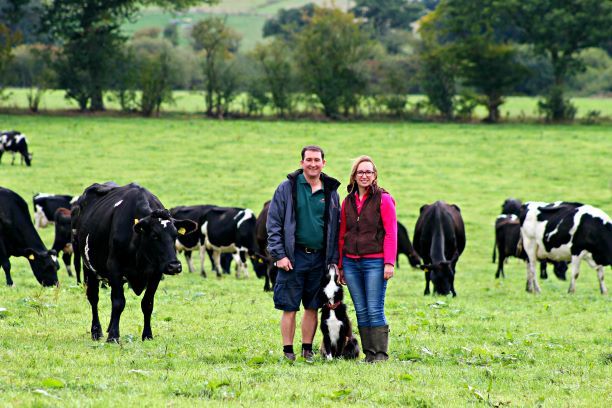How sexed semen is paying off for Shropshire dairy farmer
Fertility is the main profit driver for any block calving business, so it’s little surprise that concerns over conception rates put many off using sexed semen for fear of extending their calving block.
But Tristan and Jaci Dale are hoping to reap the benefits this calving season, after taking a leap of faith and using it across all first calvers and older animals within their 320-cow herd.
As an insurance policy, the couple started serving 10 days earlier than normal on 13 May for 10 days.
“If nothing held to sexed I was in no worse position,” explains Mr Dale, who farms 190ha at Hatton Manor Farm near Church Stretton, Shropshire.
But the couple were so impressed with the conception rate of 62% achieved that they now plan on using it on maiden heifers this season as well as cows.

Why the switch to sexed semen?
They are currently breeding a three-quarter Friesian x one quarter Jersey cow with an average mature weight of about 450kg to suit their grazing system.
However, one downside is that dairy bull calves are worth very little money, often fetching just £50 at 10 weeks old.
“In reality they are a cost to the business,” Mr Dale admits.
The Dales saw sexed semen as a way to maximise their beef calf sales but had previously decided against using it because of historically low conception rates.
“It can’t be overestimated how crucially important it is to get those cows calved,” he says. “We dry off on the same day so if a cow has calved in week nine that’s nine weeks of milk we miss.”
Using sexed semen also means they can serve their very best and most fertile animals at the front of their block to produce heifer replacements. Meanwhile, the remainder get served to beef which Mr Dale says is a “no brainer”.
Hatton Manor Farm
11.4 - Tonnes DM/ha of grass grown in 2017
8.5 - Tonnes DM/ha of grass grown in 2018
67 - Conception rate to first service using sexed semen (%)
70-72 Average conception rate to first service using conventional (%)
9 Calving period in weeks
366 Calving interval in days
SexedULTRA 4M contains double the number of female sperm cells in one straw compared with other sexed semen on the market, and as a result claims to achieve conception rates comparable with conventional semen. It was this that convinced Mr Dale to give it a go.
Although it retails at about £10 per straw more than conventional semen Mr Dale reckons the return on investment is worth it and believes the extra calves should result in an additional £10,000 profit this year (see costings in table).
Breeding policy
Mr Dale confesses to being a “bit of a maverick” and uses a simple system of tail-painting cows 30 days ahead of breeding.
“I don’t do it like a lot of people, but it works for us. We use a little bit of paint – a thin strip – and if anything is missing she gets served.”
After serving everything to sexed semen for 10 days they switched to conventional semen, and beef bulls went in on week six.
Cows calve over nine weeks starting in mid-February, and having so many heifer calves born at the start of the block should help ease calf management this spring.
“We want all the heifer calves to hit the ground first followed by the beef calves,” explains Mr Dale, who adds that reducing the heifer age range will allow them to be better managed in groups of 50 and reduce liveweight variances.
Next season, the next steps
Although the Dales say their conception rate to sexed is lower than conventional – they usually achieve 70-72% – results this year have given them the confidence to increase the use of sexed semen.
After securing Leader funding to help install a new handling system at their youngstock unit, they will now AI all maiden heifers, which normally just run with an Aberdeen Angus bull, to sexed semen.
“Next season we are going 100% sexed semen and I’m only going to use conventional beef,” Mr Dale says.
Field-to-Yield Farming
- Milking 330 cows this spring
- Spring block calving
- Organic, with milk supplied to OMSCo
- 190ha farmed, taking on another 52ha this year (242ha total)
- Producing 4,500 litres at 4.5% butterfat and 3% protein
- Milking twice daily
- Grazing from March until December
- Two full-time staff and one part-time
|
Costings |
|
|
Conventional semen results |
Value at birth (£) |
|
100 dairy heifers |
£100 |
|
65 beef heifers |
£100 |
|
65 beef bulls |
£120 |
|
100 dairy bulls |
£0 |
|
Total value of calves: |
£24,300 |
|
Net when deducting semen: |
£19,400 (semen costs of £4,900) |
|
Sexed semen results |
|
|
100 dairy heifers |
£100 |
|
119 beef bulls |
£120 |
|
119 beef females |
£100 |
|
Total value of calves: |
£35,380 |
|
Net when deducting semen: |
£29,629 (semen costs of £5,751) |
|
Difference: |
£10,229 (£29,629 – £19,400) |
find out how much you could make...
Please submit your details below and we will get in touch to produce a personalised herd audit on your farm, which will tell you your cost benefit of using this strategy! Please enter your post code into the message field.